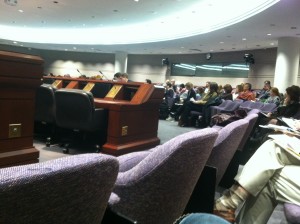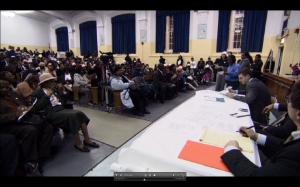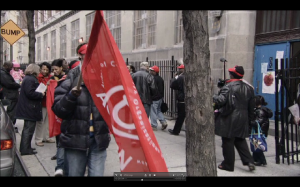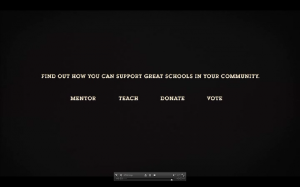The School-to-Prison Pipeline is a term coined to describe the funneling of elementary and secondary students from the classroom into the courtroom. Students are often guided toward the criminal justice system by policies utilized in schools by faculty, administration, and law enforcement; this ongoing process only increases recidivism rates among youth. Various reformers have developed strategies to combat the forces of the pipeline. These strategies tackle the multifaceted issue through a variety of means including altering school policies, working with students outside of school to change attitudes about education, and encouraging better relationships between students and faculty.
The Elementary and Secondary Education Act (ESEA) was enacted in April 1965 as a part of President Lyndon Johnson’s “War on Poverty.” This federal statute funds primary and secondary education and places a strong emphasis on providing all students with equal access to education; additionally, ESEA focuses on high standards in schools and high levels of accountability. Despite the efforts of President Johnson to level the playing field for youth in the United States, inequality persists in the realm of public education. One such inequality is very apparent: students in low-income, urban areas are far more susceptible to the dangers of the School-to-Prison Pipeline. Various reformers have taken steps to halt the flow of students along the School-to-Prison pipeline since the ESEA was passed in 1965 although the problem persists today.
The Honorable Judge Steven Teske lives and serves as a justice in Clayton County, Georgia. Judge Teske has become renowned for his tactics in battling the school-to-prison pipeline. He looks at each and every youth offender with compassionate eyes and recognizes that they are, in fact, still young people with futures ahead of them. Teske exclaims in a blog post he writes for the Juvenile Justice Information Exchange, “We have a duty to protect kids — we have a higher duty to protect the community! Detention can protect us or it can hurt us.” Judge Teske seeks to avoid incarceration for young people at all costs, encouraging a reentry into the community, schools, and involvement in mentoring, community service, or leadership programs to promote healthy self-image and to deter recidivism. He continuously makes an effort to provide juvenile offenders with alternate sentences including community service or anger management programs rather than sending them to prison. According to a study conducted by David S. Kirk and Robert J. Sampson:
“Among…students who steered clear of the juvenile justice system, 64 percent went on to graduate high school. In contrast, a mere 26 percent of arrested students graduated high school. Of those young adults without criminal records who graduated high school or obtained GED certification, 35 percent enrolled in four-year colleges. For arrestees, 16 percent subsequently enrolled in four-year colleges” (Kirk 47).
Judge Teske’s core approach, avoiding adolescent incarceration at all costs, is not only an effective means of rehabilitating youth offenders but more specifically, it encourages these offenders to alter their course and decreases recidivism for those individuals in the long run.
Another approach taken by the Honorable Judge Jimmie Edwards is very different, but also effective. Judge Edwards mirrors Judge Teske’s idea that the incarceration of youth ought to be avoided; however, his tactics for achieving this goal are different. Edwards established Innovative Concept Academy in 2009 in conjunction with MERS Goodwill, St. Louis Public Schools, and the Juvenile Court. ICA is the only school in the nation supervised by the court system, and welcomes youth offenders and juvenile delinquents in the hopes of rehabilitating them. The school’s mission statement is posted on their website; the site states that the goal of the organization is “to increase the protective factors available to these youth which are aimed at eliminating at-risk behaviors that negatively impact the St. Louis community.” The school was established to ensure that at-risk youth and juvenile offenders are offered a second chance at an education inside the walls of a schoolhouse that does not utilize zero tolerance policies, employ law enforcement officers as disciplinarians, or other harsh methods to punish students. The school offers a full curriculum in math, science, English, and history for all students. There is also an emphasis placed on extracurricular activities to both keep students out of trouble and to further “challenge their minds,” according to the school website.
The Youth and Congregations in Partnership Program (YCP) is a mentoring program run out of the Kings County District Attorney Office in Brooklyn, NY. This program is geared toward youth offenders between the ages of 13 and 22. All of these juveniles must fall within certain parameters to qualify for the program: they must be within the specified age range; they must have committed a misdemeanor (not a felony) and cannot have been previously convicted of sexual offenses, arson, or other very serious crimes. The Court must refer a youth to YCP; if they are accepted into the program they will avoid incarceration as long as they follow the guidelines laid out in a contract every participant is required to sign.
Each youth is assigned a Masters Social Worker and mentors from the local community. YCP has a relationship with various religious congregations, local community service organizations, and volunteers who offer their time and services to these juvenile offenders. In addition to the mentoring each youth receives, there are also comprehensive services made available to each individual such as anger management courses, family counseling, career readiness and job placement. The youth meet with their mentor and social worker regularly for one year. In order to graduate the program, each youth must attend their meetings, be present at every court appearance they are slated to make, partake in community service projects, remain in school, and if they are old enough, have a job. This is a multi-pronged approach that seeks to intervene on the youth’s behalf in all areas in order to rehabilitate offenders and prevent recidivism.
The school-to-prison pipeline has been shown to disparately affect minority students. Although YCP was not established to serve strictly minority youth, most of the members of the program are young African American or Latino males. This highlights some of the factors that contribute to the school-to-prison pipeline that are not part of the students’ school days. Parental incarceration, blatant racial discrimination both by the media and in school, placement into foster care, and overall heightened rates of imprisonment negatively impact African American students already at risk. “Black youth are increasingly likely to have a parent in prison — among those born in 1990, one in four black children had a father in prison by age 14” (Heitzeg 6). These unfortunate circumstances contribute to the vicious cycle of recidivism: when the authority figures in one’s life are incarcerated and the media expresses the notion that young, black men are future criminals, the stereotypes become the reality as these youth cannot separate their true identity and existence from the role they are told they will play. This label is difficult to shake and causes problems both in and out of school for these students, their families, and their educators.
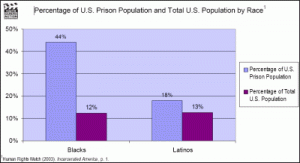
Racial discrimination is highly problematic within the school-to-prison pipeline; some reformers suggest that in order to target the pipeline, an elimination of this racism is absolutely crucial. Positive Behavioral Supports (PBS) is “an evidence-based approach to improving school discipline shown to reduce disciplinary incidents, support gains in academic achievement, and improve staff morale and perceptions of school safety” (www.pbis.org). This approach has become popular in some Midwestern schools; it is used to combat racism in conjunction with other means like “’beyond diversity trainings’ and trainings in culturally responsive pedagogy” (Cregor 7). Positive Behavioral Supports have been implemented both in schools and through daylong and residential programs; these programs encourage reopening lines of communication that have been dismantled, especially those between educators and students in the hopes that at-risk youth will not be exposed to exclusionary disciplinary policies and ultimately face detention when direct conversation between the two groups could result in avoiding punishment altogether.
One of two states that have addressed zero-tolerance policies in schools at a state level, Colorado passed Senate Bill 46, the “Smart School Discipline Bill,” in 2012. This bill became a reality due to the hard work of Padres y Jóvenes Unidos (PJU), a group of parents and students in Colorado who have joined together in an effort to encourage educational equality and justice. PJU works to tackle the harsh disciplinary practices employed in schools and places an emphasis on ending racial targeting in schools. Members have rallied together to hold schools to greater standards of accountability and have achieved great success. In September of 2010, PJU held a “Books Not Bars” conference which kick-started their legislative campaign by teaching parents and students about the forces behind the school-to-prison pipeline and utilizing student testimony about unfair treatment they receive in the classroom. By the spring of 2011, Colorado Senate Bill 133 “created a task force of elected officials, law enforcement, and community members to study the need for statewide discipline reform” (www.padresunidos.org). Ultimately, the 2012 legislative session resulted in the Smart School Discipline Bill, an amendment to the Colorado School Finance Act (HB 1345), that calls for schools to change their disciplinary codes to include minimized referral of students to law enforcement officials and instead ensures that each and every student punishment suits the infraction committed.
Padres y Jóvenes Unidos emphasizes restorative justice, an approach that focuses on both victims and offenders in the face of conflict. Restorative justice programs, sometimes referred to as victim offender mediation programs (VOM), have been found to achieve great results. Four longitudinal studies conducted throughout the 1990’s looked at a total 1,298 juvenile offenders. Among those offenders, 619 did go through VOM and 679 did not. After one year data was collected about the recidivism rates of these youth: 19% of those youth who went through a victim offender mediation program were rearrested within one year; 28% of those youth who did not go through a VOM were rearrested within the same time frame (Nugent 1). Various organizations exist with the purpose of encouraging restorative justice in public schools across the nation and the groups seeking reform are not just made up of parents and students, but educators as well. For example, Teachers Unite is an educator-led membership group that seeks to bring restorative justice to New York public schools with the ultimate goal of reaching educational and social justice for all students. Restorative justice has been a positive force in slowing the movement of the school-to-prison pipeline.
The U.S. Department of Education’s Office for Civil Rights (OCR) reports, “over 3 million students are suspended at least once each year and over 100,000 are expelled. U.S. public school discipline rates have never been higher—roughly double today what they were in the 1970s” (Cregor 5). Since the enactment of the ESEA, the rates of intense punishment have only increased; however, attempts have been made to curb suspensions and expulsions. Naturally, policy implementation has been a means of halting the pipeline in various areas across the United States. The second of two states to tackle school disciplinary policies at the state level is Florida. The state legislature of Florida amended state statutes pertaining to zero tolerance policies in school in response to the high rate of student arrests that occur in the state. Provision 1006.13 of the state statutes describes the “policy of zero tolerance for crime and victimization” in schools. Provision 1006.13 requires that zero-tolerance policies must be non-discriminatory and that schools thoroughly define which infractions will result in student arrest, as well as the establishment of “a procedure that provides each student with the opportunity for a review of the disciplinary action imposed.” The statute also limits the amount of time for which a student can be suspended and calls for schools to handle disciplinary infractions to the best of their abilities before contacting law enforcement officials. Refraining from arresting students for infractions like dress-code violations, minor incidents of vandalism (for example, the carving of one’s name in a desk), or tardiness limits the students’ involvement with the criminal justice system and prevents the relationships between students and teachers from irreparable damage.
The school-to-prison pipeline is a major issue that plagues elementary and secondary schools across the nation and leaves indelible marks on the youth of today. Many reformers agree on the major driving forces behind the pipeline including racial targeting, overly harsh, exclusionary disciplinary policies in schools, poor communication between students and educators, and unnecessary incarceration of youth. In the documentary film The Lottery, education reformer Eva Moskowitz explains that when deciding where to build prisons, officials look at the reading levels of fourth and fifth grade African American males in public schools to determine the right locations. The fact that schools and academic performance of students is being linked to incarceration before offenses have even been committed highlight further the power of the pipeline. While various reform strategies including redirecting youth away from incarceration, the establishment of new schools for youth offenders, offender rehabilitation, positive behavioral support, restorative justice, and policy implementation have been very impressive efforts to divert the pipeline, we are in need of more and better strategies. The school-to-prison pipeline must be halted in order to protect our youth.
Works Cited
“2012 Florida Statutes.” Online Sunshine. Florida State Legislature, 01 May 2013. Web. 01 May 2013. <http://www.leg.state.fl.us/Statutes/index.cfm?App_mode=Display_Statute>.
Bush, Mike. “Judge Jimmie Edwards Sends Kids to School Instead of Prison.” Ksdk.com. KSDK, 22 Nov. 2011. Web. 18 Apr. 2013. <http://www.ksdk.com/news/article/285969/4/Local-Judge-sends-kids-to-school-instead-of-prison>.
“Community Juvenile Justice.” Juvenile Justice. Positive Behavior Supports, n.d. Web. 01 May 2013. <http://www.pbis.org/community/juvenile_justice/default.aspx>.
Cregor, Matt, and Damon Hewitt. “Dismantling the School-to-Prison Pipeline: A Survey from the Field.” Poverty & Race 20 (Jan.-Feb. 2011): 5-7. NAACP LDF. NAACP Legal Defense and Education Fund, Jan.-Feb. 2011. Web. 29 Apr. 2013. <http://www.naacpldf.org/files/case_issue/PRRAC%20journal%20Jan_Feb%202011-%20Dismantling_the_School-to-Prison_Pipeline.pdf>.
Heitzeg, Nancy A. “Education Or Incarceration: Zero Tolerance Policies And the School to Prison Pipeline.” ForumOnPublicPolicy.com. The Forum on Public Policy, 2009. Web. 23 Apr. 2013. <http://forumonpublicpolicy.com/summer09/archivesummer09/heitzeg.pdf>.
“Home.” Home. Innovative Concept Academy, n.d. Web. 18 Apr. 2013. <http://innovativeconceptacademy.com/>.
Kirk, David S., and Robert J. Sampson. “Juvenile Arrest and Collateral Educational Damage in the Transition to Adulthood.” Sociology of Education 86.1 (2012): 36-62. Web. 17 Apr. 2013. <http://soe.sagepub.com/content/86/1/36.abstract>.
“Mission Statement.” Teachers Unite. Teachers Unite, n.d. Web. 29 Apr. 2013. <http://teachersunite.net/node/335>.
Nugent, William R., PhD, Mark S. Umbreit, PhD, Lizabeth Wiinamaki, and Jeff Paddock. “Participation in Victim-Offender Mediation Reduces Recidivism.” VOMA Connections 3 (Summer 1999): 1-12. Print.
“Policies Proposed, Change Demanded to End ‘School-to-Prison Pipeine'” Education Week – Rules for Engagement. 13 Dec. 2012 Web. 18 Apr. 2013. <http://blogs.edweek.org/edweek/rulesforengagement/2012/12/policies_proposed_change_demanded_to_end_school-to-prison_pipeline.html?qs=juvenile+justice+and+delinquency+act>.
Sackler, Madeleine, dir. The Lottery. 2010. Film.
“Statewide Change: 2 Years in the Making.” Home. Padres Y Jóvenes Unidos, n.d. Web. 01 May 2013. <http://www.padresunidos.org/statewide-change-2-years-making>.
“Study: Student Arrest Leads to Push Out, Low College Attendance.” Education Week – Inside School Research. N.p., n.d. Web. 17 Apr. 2013. <http://blogs.edweek.org/edweek/inside-school-research/2012/11/study_student_arrest_leads_to_.html?qs=school+discipline+prison+pipeline>.
Teske, Steven. “Resisting the Temptation of Jail: The Lesser of Two Evils.” Juvenile Justice Information Exchange. JJIE, 11 Mar. 2013. Web. 17 Apr. 2013. <http://jjie.org/resisting-temptation-of-jail-lesser-of-two-evils/106534>.
“The Smart School Discipline Law.” Home. Padres Y Jóvenes Unidos, n.d. Web. 01 May 2013. <http://www.padresunidos.org/smart-school-discipline-law>.



